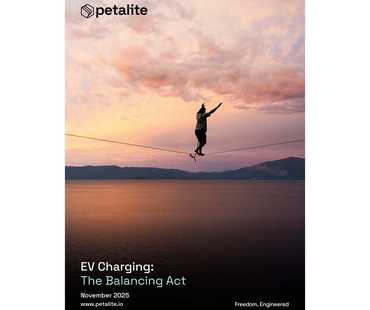Whitepaper Download
Complete the adjacent fields to download Petalite's whitepaper EV Charging: The Balancing Act
The UK’s rapid and ultra-rapid electric vehicle (EV) charging network is expanding fast — but creating a viable network which is sustainable for the long term depends on delivering a seamless experience for drivers and stronger commercial performance for operators. In the past, CPOs rolled out charging sites ahead of EV adoption, driven by a race to secure prime locations. However now, the “build it and they will come” era has passed.
This is the balancing act: to build networks that are both commercially sustainable – and trusted by drivers. This whitepaper explores this balancing act in detail. It champions the ambition and resilience of UK CPOs, highlights the pressures they face, and reflects the expectations of today’s drivers. It also looks ahead to the next stage of growth — one requiring not just more chargers, but also next generation charging technology.

PDF 1.2mb
For a full overview of all findings, download the whitepaper.

Complete the adjacent fields to download Petalite's whitepaper EV Charging: The Balancing Act
Petalite’s research with public Charge Point Operators (CPOs) leading the UK’s rapid network rollout, and with EV drivers who depend on it, reveals an industry striving to balance ambitious growth with a sharper focus on performance.
Despite more than 17,734 rapid and ultra-rapid chargers now installed nationwide, reliability, cost pressures, and utilisation remain the key challenges on the road to sustainable growth.
700 EV drivers across the UK were surveyed about their vehicle usage, charging habits and experiences of using the UK's rapid/ultra-rapid charging network providing a number of key insights...
Drawing on independent, in-depth interviews with key decision-makers at UK CPOs installing and operating rapid/ultra-rapid DC chargers, our research reveals the key factors shaping the current landscape...
The next stage of growth — requires not just more chargers, but also next-generation charging technology.
The next stage of growth — requires not just more chargers, but also next-generation charging technology.
Petalite’s unique AC-DC conversion technology allows control of many power modules simultaneously - thereby providing a better distributed system. Conventional solutions can typically only parallel up to 8-12 power modules.
Our Power Hub contains up to 84 independently controlled 25kW power modules, delivering up to 2.1MW across as many as 36 connectors.
Petalite’s unique dynamic power management operates across the entire system, ensuring power is distributed to wherever its needed most, to utilise grid capacity more efficiently.

Public charging in the UK is at a pivotal point. Driver expectations are clear, operator ambitions are high, and operational pressure combined with industry headwinds are slowing progress. The decisions made now — about technology, site strategy, and policy — will define not only the commercial success of CPOs, but also the pace of the UK’s EV transition.
As Petalite’s research shows, CPOs are already embracing distributed architecture with dynamic power management as the cornerstone of future network design. It is a solution that maximises site utilisation, transforms profitability, and answers drivers’ core needs of speed, reliability, availability, and ease of use.
Petalite’s patented SDC technology demonstrates how this can be achieved in practice: high-power performance, scalable hubs, and built-in redundancy to ensure reliability at both the physical and digital level.
Success will go to those who grow ambitiously today while building profitable, resilient networks ready for tomorrow’s vehicles.